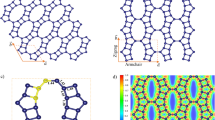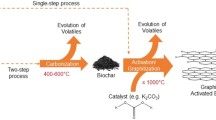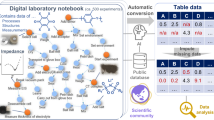Abstract
IT is well known that potassium atoms lodge themselves between the basal planes of the graphite lattice to produce intercalation compounds in many different forms of graphite1. Glassy carbon is a very defective, randomly oriented polycrystalline form for which the 0002, 10&1bar;0 and 11&2bar;0 lines are very diffuse but clearly present. Intercalation compounds in such a material would seem to be improbable and, indeed, glassy carbon is inert to most molten metals.
This is a preview of subscription content, access via your institution
Access options
Subscribe to this journal
Receive 51 print issues and online access
$199.00 per year
only $3.90 per issue
Buy this article
- Purchase on SpringerLink
- Instant access to full article PDF
Prices may be subject to local taxes which are calculated during checkout
Similar content being viewed by others
References
Übbelohde, A. R., and Lewis, F. A., Graphite and its Crystal Compounds (Clarendon Press, Oxford, 1960).
Rüdorff, W., and Schülze, E., Z. Anorg. Allgem. Chem., 277, 156 (1954).
Fischbach, D. B., Carbon, 5, 565 (1967).
Author information
Authors and Affiliations
Rights and permissions
About this article
Cite this article
HALPIN, M., JENKINS, G. Disruption of Glassy Carbon in Potassium Vapour. Nature 218, 950 (1968). https://doi.org/10.1038/218950a0
Received:
Issue date:
DOI: https://doi.org/10.1038/218950a0
This article is cited by
-
C-K (Carbon-Potassium) System
Journal of Phase Equilibria and Diffusion (2008)
-
C-Na (Carbon-Sodium) System
Journal of Phase Equilibria and Diffusion (2007)
-
Newer Forms of Carbon and their Uses
Nature (1969)
-
Heat of Combustion of Vitreous Carbon
Nature (1969)
-
Interstitial Compounds of Potassium with Carbon Fibres
Nature (1968)



